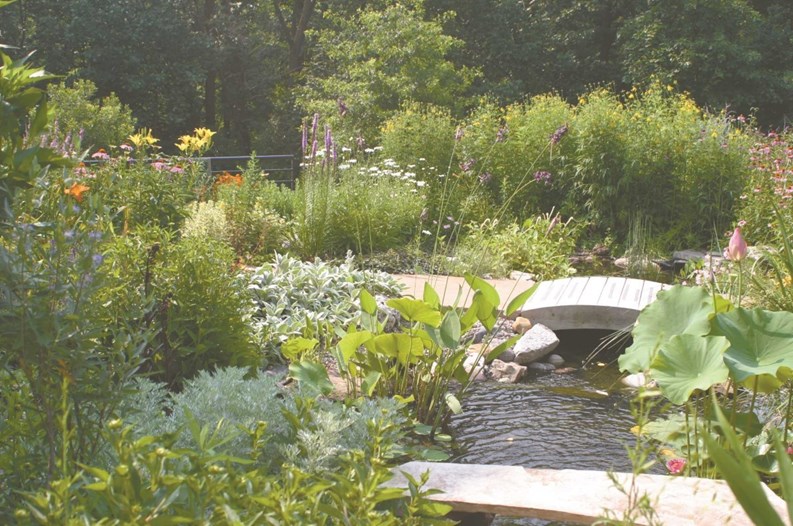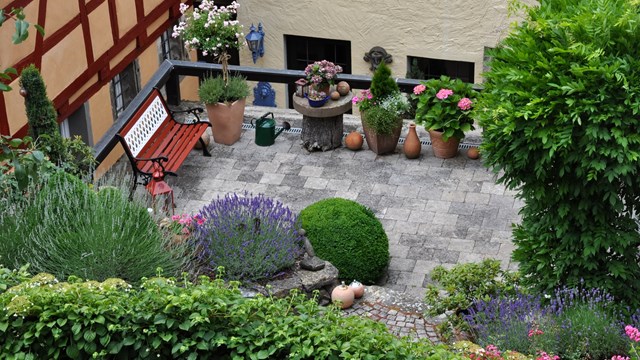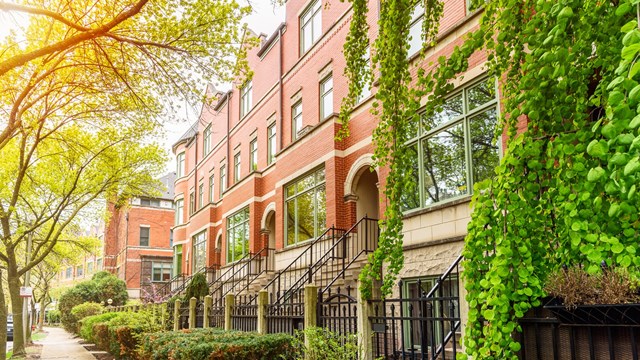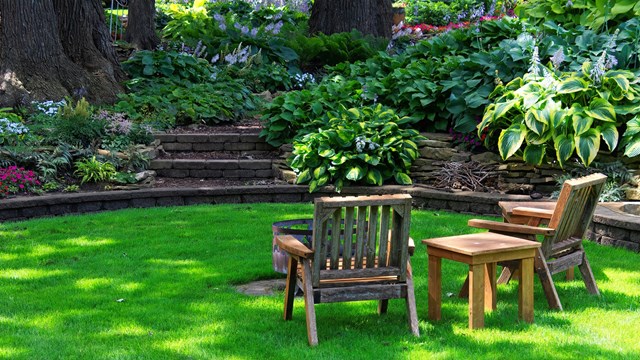These days, money is tight for just about everybody, including the boards and managers trying to run the day-to-day business of their condo community or homeowners association. Everyone is looking to get maximum return on all expenditures—and that includes landscaping and lawn care.
Handsome landscaping is great of course—it pleases residents and adds to a community's curb appeal, which in turn increases value—but there is a trend in certain areas towards landscaping that actually does something in addition to looking nice; collecting or rerouting rainwater, acting as insulation on a rooftop, growing edible plants and vegetables, and so forth.
Chicago has emerged as a leader among American cities in terms of implementing many of the technologies that have come to define the ”green movement” in this country. Mayor Richard M. Daley, who is leaving office in May, vowed to make Chicago “the greenest city in America,” and greatly helped lead the way by supporting legislation and press favoring functional landscape features and strategies—most notably the green roof that sits on top of City Hall. But functional landscaping is not just for the government and large corporations; residential properties can play a vital role in establishing a regional network of environmentally-conscious features, and can even save some money along the way.
Lawn Wars
The lushly green, meticulously manicured lawn is an enduring symbol of the American Dream—it lies right behind the white picket fence, after all. But iconic as it is, the lawn is also one of the most environmentally unsound landscaping schemes there is. Although grasses once dominated huge swaths of the Midwestern landscape, today's high-maintenance bluegrass carpets are anything but natural.
“We only have 1/100th of one percent left of what was once tall grass prairie here in Illinois,” says Dennis Paige, an environmental educator, naturalist, landscaper, and conservationist. “Lawns, as much as people like them, are basically green deserts. When you cut lawns all the time, you knock out the seed banks, you shrink the root systems and you create an inability for the soil to break down and biodegrade, and it hardens the soil. The reason we have such great soils here is because of the deep root systems of the heritage prairie grasses that existed here for such a long time.”
The primacy of the bluegrass lawn may be fading however, as attractive, more ecologically-friendly options become more readily available and more heavily promoted by landscapers and lawn experts. “There is a definite trend toward using native grass instead of bluegrass lawns,” says Daniel Weinbach of Daniel Weinbach & Partners Ltd, Chicago. “In fact, the mayor has pushed this.”
There are some very good reasons to consider new alternatives to lawns, say the pros. For starters, lawns generally require repeated applications of multiple chemicals: pesticides, herbicides, and fertilizers, among others. These chemicals all wash into the water systems, from the creeks to the rivers to the lakes and oceans, where they accumulate and impact aquatic ecologies.
In addition to the chemicals, lawns require nearly constant maintenance, which affects the air as much as the water. “In terms of environmental impact, one riding lawn mower equals 650 miles in a car,” says Paige. “When you do eco-gardening, however, after the first year or so, they largely maintain themselves because this is basically their piece of the planet.”
Vegetables, Insulation & More
There are many different kinds of functional landscape features—many of which are excellent alternatives to conventional bluegrass lawns.
Water management is one key area where HOAs can see immediate, noticeable effects, says Weinbach. “Rain gardens, bio-swales and permeable pavers are all methods for reducing the influx of storm water into traditional sewer systems, so that instead of putting in catch basins and a sewer system, you can handle storm water through natural means. The water is then stored in the ecosystem, instead of running into the storm system.”
Vegetable gardens are gaining popularity as well, offering homeowners not only the chance to choose chemical-free, non-gentically modified produce, but also providing a great community-building activity all residents can participate in.
Green roofs can often act as gardens in the sky, and serve multiple functions as well: “Green roofs are a growing trend and are definitely functional for saving money on energy bills,” says Renee Mercer of Kinsella Landscape, Inc., who works in the Blue Island office of the firm. “They save on heat, air conditioning, the whole nine yards, and aesthetically, you are looking at a garden as opposed to a tar roof.”
“A green roof acts as a kind of insulation to prevent heat loss, and can also capture a certain amount of rainwater,” adds Weinbach. “It’s an overall benefit to the city, since it helps to prevent the rapid rush of storm water into the sewers. Instead, the water is stored on the roof. It reduces the heat island effect, and the insulation will provide energy savings.”
Recycled materials are also on the list of functional landscape strategies, says Carolina Garcia of Culturelle3 Designs, Inc. in Chicago. “The use of recycled pavers—or any kind of pavers that have material that can be taken off of the landfill—has an immediate positive effect on the ecology of the land,” she says. “Things like rubber or plastics or glass can be used in these pavers. There are several companies that are using landfill materials for some of these hardscape products. They are beautiful and they are extremely beneficial to the environment.”
Returns – and Chicagoland Specifics
Healthy foods often cost more than junk food….is the same true of a healthy landscape?
“Bio-swales and permeable pavers can pay for themselves over time, because the water savings will begin immediately,” says Weinbach. “Green roofs probably have a 10-20 year return.”
“When you start putting in rain barrels and collecting water, that’s an immediate result and return,” adds Garcia. “You can cut down the use of potable water immediately, and begin using what you have reserved in the rain barrel.”
More functional landscaping can sometimes eliminate costly upkeep regimens entirely, says Mercer. “Using native plants can sometimes eliminate the use of irrigation systems. Minimal maintenance, watering, and chemical applications… many of these rooftop gardens can basically sustain themselves.”
Some kinds of longer-term eco-planning can have direct results on the bottom line as well, says Paige. “For example, native trees appreciate the property after a couple of years by about 10 percent.”
“The economic downtown has meant that everyone wants everything cheaper, faster, and more economical,” says Mercer. “We have harsh winters in Chicago, it’s very windy, and we have a major freeze/thaw event every year. It also gets very hot here in summers, making the parking lot areas especially hot. The salt from snow removal dictates the type of plants that we can use in some cases. We also have a very particular city in terms of the kinds and sizes of trees that can be installed. We want to create and maintain as green a city as possible.”
If You Build It They Will Come
Paige, for example, has been able to implement a number of these landscape features into his own multifamily housing organization in Schaumburg.
“I began on a small scale on my own condo building about 15 years ago,” he says, “trying to introduce native plants to the almost 10 acres that the condo association occupies. I started to incorporate a broader scope to the rest of the property, into a combination of woodland, prairie, wetland and rain gardens.”
Some of the landscape features that Paige has installed have needed time to come into their own as truly functional. “I’m trying to return to a heritage-based landscape, one that refers back to the savannah and oak/hickory woods,” he says. “It’s a patchwork landscape that existed here prior to our development.”
If the idea of “native” grasses and plants conjure images of unruly prairie grasses and waist-high thistles overtaking your condo grounds, it's important to remember that having functional landscape features doesn’t mean that the aesthetics of your community areas will suffer. In fact, the opposite is usually the case, though that's sometimes not so easy to convey to residents: “Living in a condo complex means that many other people are involved in the decision and the process, “ says Paige.
“The aesthetic value has a lot to do with the designer,” adds Garcia. “The designer should have that vision so that whether you are using a regular paver, a recycled material paver, or a rubberized sculpture in some way, they should all have sound aesthetic value. We don’t want these new technologies to suffer from aesthetic disappointment.”
Paige recommends easing a community into the kind of thinking that may help support the large-scale use of some functional landscape features. “I think the main thing to consider is working out a project that’s not gonna be so big…start with an experimental section,” he says. “That way you can show the results on a small scale, and the community will start to support the effort.”
And don’t be afraid to look around for help, Paige continues. “Hooking into larger organizations like the Chicago Wilderness can help create a bigger picture, so that a larger regional connection is achieved,” he says. The sustainability of the area will rely on the patchwork of smaller solutions that are implemented across the region. They help us look at land differently and accommodate biodiversity, and they can provide technical support and professional expertise along the way.”
If it seems like a lot of effort, you may want to consider some of the less obvious benefits, says Paige. “Cutting down on pesticides is helpful for the health of people, and the aesthetics of a heritage landscape versus a lawn and trees landscape is music for the eyes. We have birds and other wildlife that are visiting our condo complex that are deep woods wildlife. It’s really amazing to see them here. Providing habitat for deep woods songbirds and stimulating biodiversity is really cool. If you build it they will come.”
Denton Tarver is a landscape architect and freelance writer living in New York City.







Leave a Comment